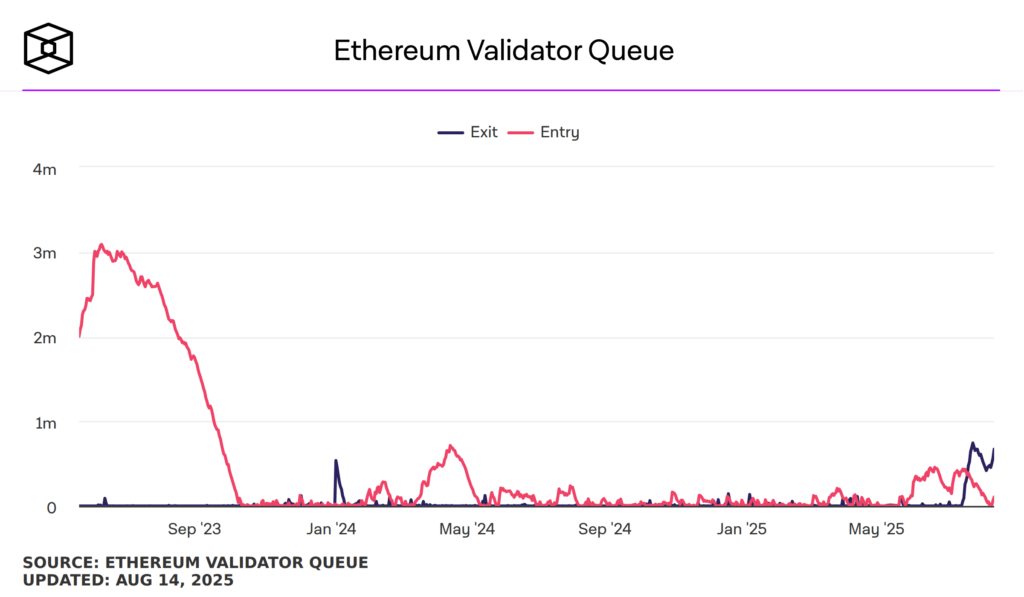
Main Points:
- Validator exit queue has surged to ~700,000 ETH (≈ $3.2–3.3 billion), with waits of ~12–13 days.
- Exit volume significantly exceeds new staking entries; entry queue holds
105k–223k ETH ($0.5–1.0 billion). - Key drivers: profit-taking amid ETH price rally, LST depeg risks, unwinding leveraged staking loops.
- Major liquid staking providers (Lido, EtherFi, Coinbase) appear to lead large withdrawals.
- Staking system remains stable; 35 million ETH (~30% of supply) still staked, sustaining rewards (~3% APR).
- Structural constraints (churn limits, queue delays) expose scalability/liquidity limits in high-stress scenarios.
- Growing need for protocol enhancements to ease withdrawal flows and improve liquidity management.
1. Validators Exit Queue Swells Dramatically
The Ethereum validator exit queue has ballooned to nearly 700,000 ETH, valued between $3.2 billion to $3.3 billion, with withdrawal delays now averaging 12 to 13 days. At the lower end of estimates, one source cites approximately 671,900 ETH (~$3.1 billion). This marks one of the largest validator withdrawal backlogs in recent memory, signaling intense unstaking activity.
2. Entry Queue Lags Behind
Meanwhile, the number of ETH entering staking (the entry queue) lags: figures range from 105,000 ETH ($472 million) to as high as 223,338 ETH (~$1.06 billion). This imbalance shows that exit pressure is outpacing new staking commitments, resulting in net outflows.

3. Why Are Validators Exiting?
3.1 Price Rally & Profit-Taking
Ethereum’s price has surged (~160% since April 2025), prompting long-term stakers to cash in.
3.2 LST Depeg Risks & Arbitrage
Widening depegging of stETH relative to ETH is unsettling LST holders, motivating exits to capture arbitrage or revert to ETH.
3.3 Unwinding Leveraged Staking Loops
Validators who deployed strategies such as staking ETH, receiving LST, then borrowing against them are deleveraging due to rising costs.
3.4 Institutional Behavior & Regulatory Signals
Some withdrawals are possibly anticipating new staking products or ETFs; further, institutional entities are adjusting positions amid clearer regulatory guidance.
4. Staking Infrastructure Remains Resilient
Despite the exit surge, Ethereum’s staking ecosystem remains robust: over 35 million ETH (≈ 30% of total supply) remains staked, and average staking rewards remain around 3% APR. The system continues to process both exits and new entries, demonstrating durability under stress.
5. Structural Constraints Revealed
Ethereum’s churn limit and queue mechanism—which throttle how many validators can enter or exit per epoch—are now leading to multi‑day bottlenecks. This illustrates intrinsic scalability limits, especially during mass unstaking events.
6. Implications for DeFi and LST Protocols
6.1 Liquidity Crunch & Depeg Feedback Loops
Large withdrawals by LST providers could exacerbate depegging, impacting wider DeFi markets.
6.2 Necessity for Better Withdrawal Paths
Growing delays may drive demand for off‑chain liquidation or future protocol features to streamline exits.
7. Need for Future Upgrades
This situation underscores the need for enhancements—such as dynamic churn settings or liquidity‑enabling bridges—to improve withdrawal efficiency, reduce stress on the validator queues, and maintain network confidence.
Summary
Ethereum is seeing a massive exit surge: nearly 700,000 ETH (≈ $3.2–3.3 billion) is queued for withdrawal, with waits exceeding 12 days, while entry staking continues at a slower pace (~105k–223k ETH). Motivated by profit‑taking, LST depegs, leveraged loop unwindings, and possible regulatory or institutional rebalancing, validators are exiting en masse. Despite this, staking remains strong (35m ETH staked, ~3% APR), and the network infrastructure continues to function. However, the current stress test reveals structural limitations in the churn‑based queue system. Improving withdrawal flexibility and rethinking staking mechanics will be vital for Ethereum’s long‑term health, especially as demand for real‑world usability and financial utility grows.

